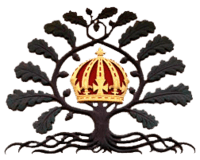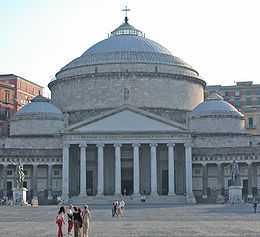Sanfedismo
| Army of Holy Faith in our Lord Jesus Christ | |
|---|---|
| Participant in revolt against Parthenopaean Republic | |
|
Cardinal Fabrizio Ruffo leading the Sanfedisti in 1799, protected by Saint Anthony | |
| Active | 1799 |
| Groups | Southern Italian peasants |
| Leaders | Cardinal Fabrizio Ruffo |
| Area of operations | southern Italy |
| Strength | 17,000 |
| Allies | Russia, Ottoman Empire, Britain |
| Opponents | Parthenopaean Republic |
| Part of the Politics series on |
| Toryism |
|---|
 |
|
Characteristics
|
|
Sanfedismo (from Santa Fede, "Holy Faith" in Italian) was a popular anti-Republican movement, organized by Cardinal Fabrizio Ruffo, which mobilized peasants of the Papal States against the Parthenopaean Republic in 1799, its aims culminating in the restoration of the Bourbon Kingdom of Naples under Ferdinand I of the Two Sicilies. Its full name was the Army of Holy Faith in our Lord Jesus Christ (Italian: Armate della Santa Fede),[1] and its members were called Sanfedisti.
The terms "Sanfedismo" and "Sanfedisti" are sometimes used more generally to refer to any religiously-motivated, improvised peasant army that sprung up on the Italian peninsula to resist the newly created French client republics.[2]
Campaign
Ruffo recruited the Sanfedisti in his native Calabria. The recruitment manifesto of February 1799 reads:
- "Brave and courageous Calabrians, unite now under the standard of the Holy Cross and of our beloved sovereign. Do not wait for the enemy to come and contaminate our home neighbourhoods. Let us march to confront him, to repel him, to hunt him out of our kingdom and out of Italy and to break the barbarous chains of our holy Pontiff. May the banner of the Holy Cross secure you total victory."[3]

The Sanfedismo movement nominally acted in the name of Ferdinand I of the Two Sicilies.[4] Ruffo was deputized by Ferdinand, while both were taking refuge in Palermo, to act as his vicar-general on the Italian mainland on January 25, 1799, two days after the proclamation of the Parthenopean Republic.[5] Ruffo landed in Calabria on February 7 with no money or weapons and only eight companions, but bearing a banner with the royal arms on one side and a cross on the other, with the inscription "In hoc signo vinces."[5] It took Ruffo a month to amass a force of 17,000;mostly peasants, but also "bandits, ecclesiastics, mercenaries, looters, devotees, and assassins."[5]
During the campaign, Ruffo corresponded with Ferdinand's agent, Sir John Acton, updating him on the military progress of the Sanfedisti:
- "I beg the king [of Naples] to order at least a thousand handguns and many loads of lead shot to be sent to me" (February 12)[6]
- "I think it would be expedient to send a frigate with a mortar against Cotrone and to destroy it absolutely" (February 26)[6]
- "Catanzaro has really surrendered; many of the worst types have been massacred, others taken prisoner" (March 8)[6]
- "Cosenza has been taken and sacked" (March 19)[6]
By the end of April, the Sanfedisti had subdued the entirety of Calabria and most of Puglia, and began a land siege of Naples in June.[5] In the siege, the Sanfedismo irregulars were supported by a British naval force under the command of Horatio Nelson,[7] for which Ferdinand gave Nelson the title of Duke of Bronte, which Nelson affixed to his signature for the rest of his life.[1] The Parthenopean Republic collapsed on June 19, 1799.
Most of the Sanfedisti victories occurred in rugged terrain, which was "well-suited" to the irregular style of warfare employed by Ruffo.[8]
Similar to other anti-French uprisings in Italy, the Sanfedisti were not, as a rule, amiable towards Jews, who were perceived as supporters of the Enlightenment ideology.[9] Furthermore, Bishop Giovanni Andrea Serrao, the Jansenist leader in southern Italy and a supporter of the Parthenopaean Republic, was summarily executed on February 24, 1799 by the soldiers of the Potenza guard, as Ruffo's forces were drawing near to the city.[10]
Legacy

The role of Cardinal Ruffo in the movement was a contemporary source of controversy, attributing to Ruffo both cruelty and bloodlust; apologist writings defending him are only extant with respect to the sack of Altamura.[6] The name of Sanfedismo itself was a source of criticism, dubbed "a word sprung up, by which this new phase of wickedness might be called" by a contemporary.[11] Sanfedismo, and Ruffo himself, became synonymous with the "recalcitrant, truly counter-revolutionary clergy" as opposed to those who were more sympathetic to the French Revolution.[12] The name "Sanfedisti" was also used by Bourbonist peasant uprisings against the House of Savoy during Italian unification.[13]
The Canto dei Sanfedisti is still remembered by heart among many in the Mezzogiorno, and sometimes sung by folk groups. It is a parody of La Carmagnole, a popular French Revolutionary song.
Later scholarly views of the Sanfedisti have dubbed them a "counter-revolutionary" group, but not homogeneously a "reaction[ary]" one.[14]
See also
- Veronese Easters
- Viva Maria
- Sanfedisti#Canto dei Sanfedisti
- Vendée Revolt
- Carlism
Notes
- ↑ 1.0 1.1 Burkle-Young, 2000, p. 7.
- ↑ Duffy, 2006, p. 260.
- ↑ Chambers, 2006, p. 180-181.
- ↑ Lord, 1970, p. 227.
- ↑ 5.0 5.1 5.2 5.3 Chadwick, 1981, p. 474.
- ↑ 6.0 6.1 6.2 6.3 6.4 Chambers, 2006, p. 181.
- ↑ Chambers, 2006, p. 182.
- ↑ Brauer and Wright, 1990, p. 67.
- ↑ Lyons, 1994, p. 22.
- ↑ Chadwick, 1981, p. 475.
- ↑ Rees, William Jennings, and Ayerst, William. 1856. The influence of Christianity on the language of modern Europe. (Available online)
- ↑ Broers, 2002, p. 90.
- ↑ Martin, 1969, p. 231.
- ↑ Robertson, 1999, p. 23.
References
- Brauer, Kinley J., and Wright, William E. 1990. Austria in the Age of the French Revolution, 1789-1815. Berghahn Books. ISBN 1-57181-374-8
- Broers, Michael. 2002. The Politics of Religion in Napoleonic Italy: The War Against God, 1801-1814. Routledge. ISBN 0-415-26670-X
- Burkle-Young, Francis. 2000. Papal Elections in the Age of Transition, 1878-1922. Lexington Books. ISBN 0-7391-0114-5
- Chadwick, Owen. 1981. The Popes and European Revolution. Oxford University Press. ISBN 0-19-826919-6
- Chambers, David Sanderson. 2006. Popes, Cardinals & War. I.B. Tauris. ISBN 1-84511-178-8.
- Duffy, Eamon. 2006. Saints and Sinners: a history of the popes. Yale University Press. ISBN 0-300-11597-0
- Lord, Walter Frewen. 1970. England and France in the Mediterranean, 1660-1830. S. Low, Marston.
- Lyons, Martin. 1994. Napoleon Bonaparte and the Legacy of the French Revolution. Macmillan. ISBN 0-312-12123-7
- Martin, George Whitney. 1969. The Red Shirt and the Cross of Savoy. Dodd, Mead.
- Robertson, John. 1999. "Enlightenment and Revolution: Naples 1799" in Transactions of the Royal Historical Society. Cambridge University Press. ISBN 0-521-79352-1
